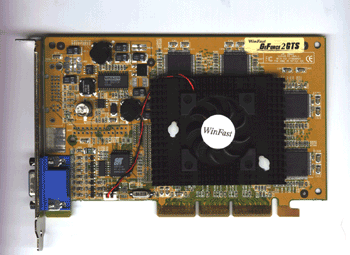
Original Link: https://www.anandtech.com/show/555
 Recent
weeks have proved to be action-packed for NVIDIA. First, about one month ago,
NVIDIA unveiled their newest graphic's powerhouse: the GeForce 2 GTS. Days later
came actual products powered by this GPU, a first for NVIDIA Now, we are seeing
the video card market becoming flooded with GeForce 2 GTS based cards. Why all
the action and efficient production times? The DDR GeForce 256 processor was,
and still remains, powerful enough for the vast majority of 3D games and application.
Why did NVIDIA create competition between their own products with the fast release
of the GeForce 2 GTS? Well, it was all because of one thing in NVIDIA's eyes,
competition.
Recent
weeks have proved to be action-packed for NVIDIA. First, about one month ago,
NVIDIA unveiled their newest graphic's powerhouse: the GeForce 2 GTS. Days later
came actual products powered by this GPU, a first for NVIDIA Now, we are seeing
the video card market becoming flooded with GeForce 2 GTS based cards. Why all
the action and efficient production times? The DDR GeForce 256 processor was,
and still remains, powerful enough for the vast majority of 3D games and application.
Why did NVIDIA create competition between their own products with the fast release
of the GeForce 2 GTS? Well, it was all because of one thing in NVIDIA's eyes,
competition.
NVIDIA felt that soon it could lose its position as king of the hill. Although they had quite a margin over competing products, talk of the upcoming Voodoo V5500 sent shivers running down NVIDIA's spine. Rather than banking on the fact that 3dfx would err yet again, NVIDIA decided to push ahead with their V5500 killer, the GeForce 2 GTS. This well timed business maneuver resulted in a swift blow to the majority of 3dfx's prospective market. The swift release of the GeForce 2 GTS along with the announcement from 3DFX's about a week ago saying that the Voodoo V5500 would be delayed yet again, all but ensured that NVIDIA would remain on top of the world for at least one more product cycle. This also resulted in a wave of GeForce 2 GTS based cards; many more than were ever seen in the first 2 months of the GeForce 256's release, let alone 4 weeks.
With almost every manufacturer jumping aboard, we were not surprised to see Leadtek produce a GeForce 2 GTS based card along with all of the other manufacturers. Unlike the GeForce 256 based WinFast series from Leadtek, the WinFast GeForce 2 GTS was not the first GeForce 2 GTS card to hit the market. This extra time should ensure for a solid product, as it gave Leadtek time to work out any problems that may have arisen. Let's see if this is indeed the case, as well as examine some of the features of the new Leadtek WinFast GeForce 2 GTS.
|
Key Features |
|
Giga
Texel Shading Architecture
|
|
32
MB high-speed DDR SGRAM memory
|
|
TV-Output
option
|
|
Super
size heatsink- 220% size increase
|
|
Full
Support on 3D Platforms
|
- 2nd-generation GeForce GPU with Giga Texel Shading Architecture 8 texels per clock with Advanced Hypertexel pipelines
- Most complete DirectX7 hardware implementation for the highest gaming quality and frame rate
- High Definition Video Processor for the fastest DVD, 2D and video processing (with enhanced motion compensation)
- 32MB DDR memory
- Super Size Heatsink (220% size compared to regular size)
- WinFastDVD playback package
- Optional TV output (w/
flicker filter) and DVI Interface
Bundle Software - WinFast DVD
- Colorific
- 3Deep
- True Internet Color
- Cult3D
|
Refresh Rate Support |
||
|
Resolution |
Color |
Max Refresh Rate (Hz) |
|
640 x 480 |
256/65K/16M |
60 - 240 |
|
800 x 600 |
256/65K/16M |
60 - 240 |
|
1024 x 768 |
256/65K |
60 - 240 |
|
1024 x 768 |
16M |
60 - 200 |
|
1152 x 864 |
256/65K |
60 - 200 |
|
1152 x 864 |
16M |
60 - 170 |
|
1280 x 960 |
256/65K |
60 - 170 |
|
1280 x 960 |
16M |
60 - 150 |
|
1280 x 1024 |
256/65K |
60 - 170 |
|
1280 x 1024 |
16M |
60 - 150 |
|
1600 x 900 |
256/65K |
60 - 150 |
|
1600
x 900
|
16M
|
60
- 120
|
|
1600
x 1200
|
256/65K
|
60
- 120
|
|
1600
x 1200
|
16M
|
60
- 100
|
|
1920
x 1080
|
256/65K
|
60
- 100
|
|
1920
x 1080
|
16M
|
60
- 85
|
|
1920
x 1200
|
256/65K
|
60
- 100
|
|
1920
x 1200
|
16M
|
60
- 85
|
|
1920
x 1440
|
256/65K
|
60
- 85
|
|
1920
x 1440
|
16M
|
60
- 75
|
|
2048
x 1536
|
256/65K
|
60
- 75
|
|
2048
x 1536
|
16M
|
60
|
The Card
The most visually shocking aspect of the Leadtek WinFast GeForce 2 GTS is, without a doubt, its enormous heatsink. Judging by the size of the heatsink, a whopping 7.5 x 6 cm (compared to the 4.5 x 4.5 cm heatsink found on most video cards), Leadtek must have received great response from their WinFast GeForce 256 DDR Revision B card, their first product to employ an extremely oversized cooling solution. The problem is that the huge heatsink on the WinFast GeForce 2 GTS serves essentially no purpose besides impressing friends, a moot point considering that the card is placed inside the computer. We noticed a large improvement when overclocking the WinFast GeForce 256 DDR Revision B card due to its oversized heatsink, but due to the nature of the GeForce 2 GTS chip, this improvement is all but gone, even with the use of thermal grease to bond the heatsink to the GPU.
Unlike the GeForce 256 GPU, the GeForce 2 GTS with its .18 micron architecture, does not get extremely hot. By shrinking the die size of the chip, NVIDIA was able to significantly reduce the amount of heat produced in the core. Due to this reduction of the die size, the GeForce 2 GTS no longer runs at temperatures hot enough to burn a person's skin. Instead, a normal sized heatsink on a GeForce 2 GTS has temperatures that are only hot to the touch. By employing a heatsink that is "220% greater" in size than the standard heatsink, Leadtek was able to reduce this temperature even further, so that the heatsink is room temperature to the touch, however, this additional drop in heat does not produce any additional overclockability, as shown and discussed in the overclocking section.
Heatsink aside, we can move on to the more conventional aspects of the card. Like every other GeForce 2 GTS-based card we have seen out there, the Leadtek WinFast GeForce 2 GTS is based upon NVIDIA's reference design for board layout. Most manufacturers chose this route for one reason: less production costs. By maintaining NVIDIA's reference design, Leadtek was able to produce a card without the added production time associated with producing a proprietary board design. In order to be a contender in the quickly paced world of video cards, it is necessary to get a product out in the hands of the consumer as soon as possible. By utilizing the reference design, no additional research and development is needed, meaning that production time and production cost are decreased. Both of these factors are essential for the production of a new video card.
The card utilizes the same memory solution we have seen in every DDR card since the original DDR GeForce 256. Using eight, 4 MB Infineon DDR SGRAM chips rated at 6 ns, we can expect the RAM on the WinFast GeForce 2 GTS to perform similarly to the memory clock on other recent video cards. It seems that long gone are the days when DDR SGRAM chips would rarely break their rated speed limit of 166 MHz DDR (333 MHz). Since the memory clock of the card is shipped at this 333 MHz mark, you can be certain that the problems that plagued the initial DDR memory batches are gone. Also worth noting is the fact that, currently, the Infineon SGRAM chips only come in the 6 ns variety. This should change later in the summer when Infineon plans on releasing 5.5 and 5 ns SGRAM chips for use in GeForce 2 GTS cards.
One option not seen on our test card but one that is available nonetheless is TV-out. Sold as an in-box option and not an upgrade module like other companies, the video-out version of this card is slated to run a mere $10 more than the base price of $349. Costing a small fraction of the total card cost, it seems that even if you do not plan on utilizing the video-out, it would be a nice feature to have at a nice price. A DVI port on the back is an option as well.
Overclocking
Why does the oversized heatsink make no difference in card performance when overclocked? Well, as discussed in-depth in our Overclocking the GeForce 2 GTS guide, there are two main limiting factors when it comes to overclocking. The first problem, and the only one that can be alleviated during card manufacture, is heat. When any processor is overclocked it produces more heat than normal due to the extra work being done. By implementing an efficient cooling method, such as an overly large heatsink, companies are able to cut down on the internal temperature of the core by transferring heat to the surrounding air via a heatsink. By decreasing this internal temperature, the core is able to operate at higher speeds because it is able to go at faster speeds before the critical temperature is reached, a point where vital electronic components of the chip begin to fail. However, we all know that cooling a chip down to well below freezing does not result in infinite clock speeds. Therefore, there must be some other factor in overclocking.
This other factor comes with chip quality, which is actuality a function of transistor conductivity. Since transistor conductivity varies from chip to chip, each batch of GeForce 2 GTS chips produces chips of varying quality. The result of this is that each GeForce 2 GTS chip will respond to overclocking differently. The lowest "quality" chips will not make it much over the rated speed of 200 MHz. Other chips, those of "higher" quality, may make it as high as 245 MHz. The problem is that neither the card manufacturer nor the card consumer can know which chips are of "highest" quality. Therefore, overclocking results vary.
Since the core temperatures of the GeForce 2 GTS are so much lower than those of the GeForce 256, we found in our Overclocking guide that heat is not the limiting factor in GeForce 2 GTS overclockablity. What this means is that rather than a card being able to overclock better or worse depending on its cooling method, almost all GeForce 2 GTS based cards will overclock almost identically no matter what type of heatsink and fan they use. Because heat is not an issue for the GeForce 2 GTS, the overly large heatsink does nothing more than add production cost and attract ill-informed consumers. This is shown by the card's ability to overclock to a 232 MHz core, right in the range that we have been able to overclock other GeForce 2 GTS based cards, regardless of cooling method. The one and only factor that effects overclockability in the GeForce 2 GTS is chip quality.
This same principal holds true for the RAM. RAM has never really had a problem with heat, thus overclockability is a function of chip quality. As stated in The Card section, the quality of Infineon SGRAM chips has dramatically improved from the quality seen in pre-GeForce 2 GTS cards. Every GeForce 2 GTS card we have tested has been able to reach a memory speed of at least 360 MHz and the Leadtek WinFast GeForce 2 GTS was no exception, as the card was able to reach a maximum memory speed of 365 MHz when both the core and the memory were overclocked.
The Drivers
The driver set included with the Leadtek WinFast GeForce 2 GTS is the same as the drivers that came with the WinFast GeForce 256 DDR and SDR cards except with an upgraded back-end to NVIDIA's 5.16 reference driver set. Below is the driver section from these reviews.
Many companies have recently moved from developing their own drivers and utilities to using the standard drivers produced by NVIDIA. While this, in theory, reduces production cost and testing times, it often leaves us clinging to the days when reference drivers were not as common. Because Leadtek wished to get their GeForce card out on the market quickly, they opted to take the road that many companies travel by adding a few enhancements to the reference driver set but leaving others untouched.
This production method results in drivers that are almost identical to their competing counterparts. Luckily, the reference drivers do contain the features that most users would need. Leadtek improves upon these features by adding custom graphics and a few handy tools. For example, the taskbar resident driver utility provides quick access to not only video card options but also to a few commonly used Windows screens and features, such as Add/Remove Programs and desktop refresh. On the other hand, the Direct 3D and OpenGL settings are exactly the same as those found in the reference drivers, with the addition of the Leadtek graphic in the back.
The overclocking option that is found in the driver utility is similar to the reference driver overclocking utility. It allows the user to push the core speed and memory speed of the card to new heights without having to use a third party application such as Power Strip. It is always nice to see that companies have enough pride in their products to know that overclocking is a viable possibility.
Another interesting feature of the Leadtek driver set is the included Eye Protection utility. When enabled, this feature can remind you to rest your eyes at an hourly rate specified by the user. While the word of the wise dictates that we should take breaks from computer use, it is quite unlikely that a small dialogue box will motivate us to take a break. This feature seems like more of a work orientated option, as it gives the worker an excuse to take a break. The phrase "But my computer told me to" comes to mind.
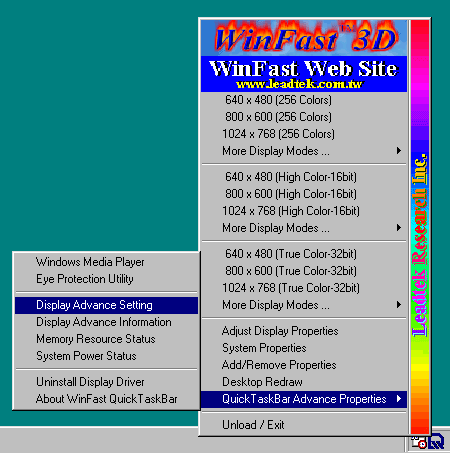
While very similar to the
NVIDIA taskbar utility, Leadtek's bar provides easy access to commonly used
features.
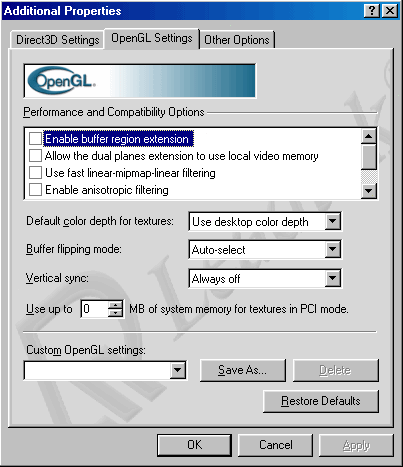
The OpenGL settings are the
same as those found in the standard NVIDIA drives.
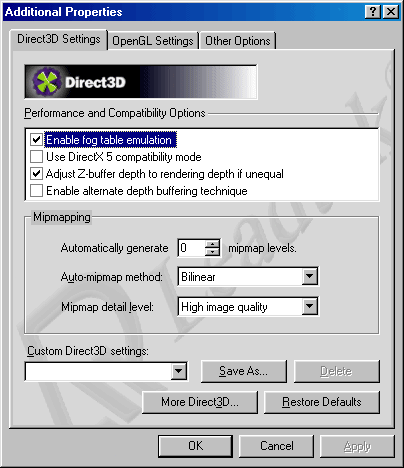
The standard NVIDIA Direct3D
screen is also found.
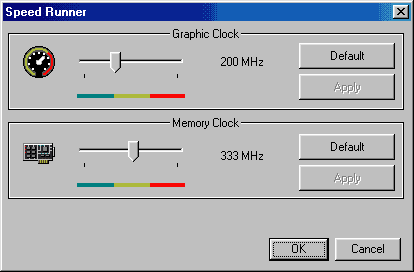
Also included is Speed Runner,
the overclocking utility.
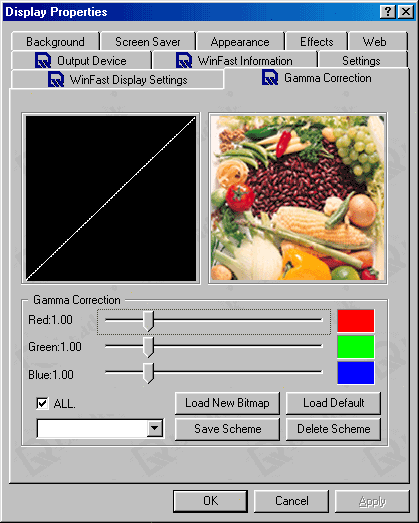
Color adjustments are easily
made.

The Eye Protection utility.
Yes, the picture is to scale.
The Test
|
|
Windows
98 SE Test System
|
|
|
Hardware
|
|
CPU(s) |
Intel Pentium III 750E |
| Motherboard(s) |
ABIT
BF6
|
| Memory |
128MB PC133 Crucial Technology SDRAM |
| Hard Drive |
Quantum Fireball CR 8.4 GB UDMA 33 |
| CDROM |
Acer 24x |
| Video Card(s) |
Leadtek WinFast GeForce 2 GTS |
|
|
Software
|
|
Operating System |
Windows 98 SE |
| Video Drivers |
|
|
|
Benchmarking Applications
|
| Gaming |
GT
Interactive Unreal Tournament 4.04 UTbench.dem |
Quake III Arena Performance- demo 001
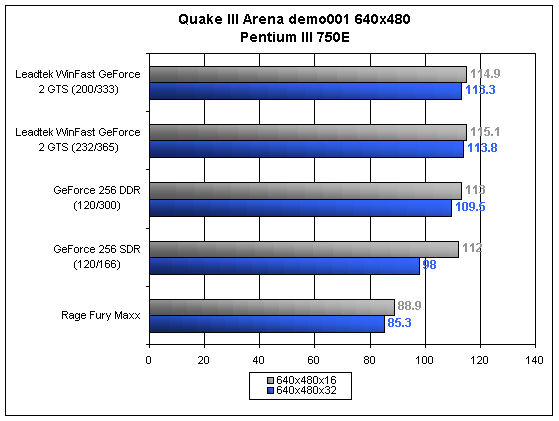
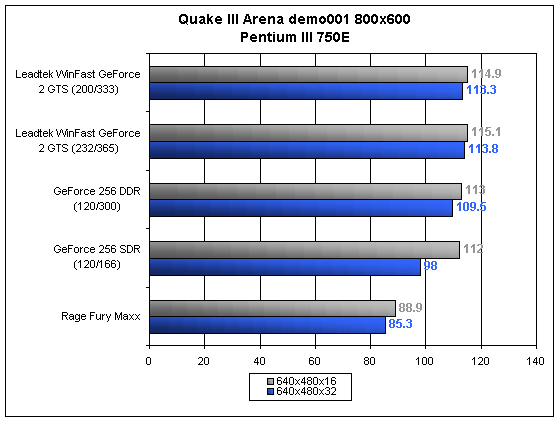
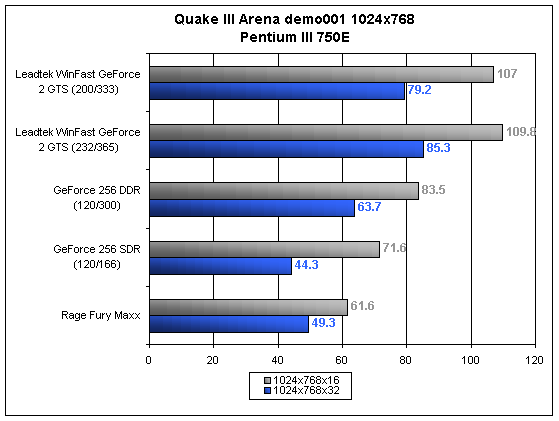
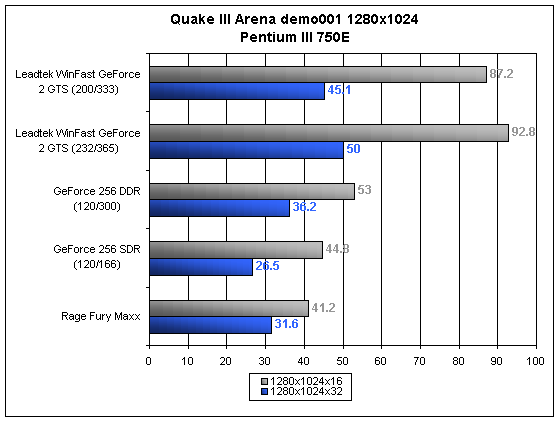
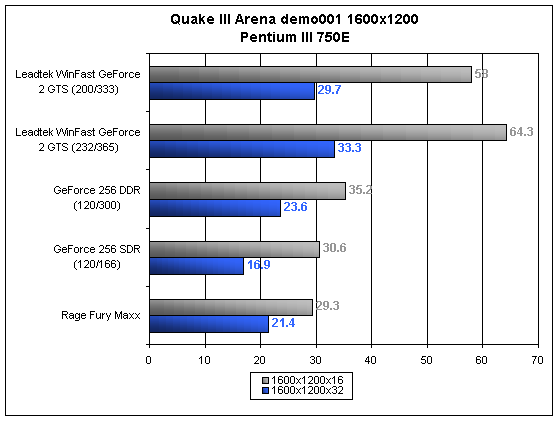
The Quake III Arena demo001 results show us what we have come to expect from the GeForce 2 GTS. At lower colors and resolutions, the new processor does not excel substantially over its older brother. It is not until the color depth and resolution is cranked up do we begin to see the true power of the GeForce 2 GTS. At 1600x1200x16 the WinFast GeForce 2 GTS smokes the GeForce 256 DDR by 65%, the same margin seen in other GeForce 2 GTS based cards. You may note that the largest speed increases come when in 16-bit color. This is due to the memory bottleneck that the GeForce 2 GTS has, as described in our Overclocking the GeForce 2 GTS guide.
When overclocked, the performance of the card jumps even further. At the same resolution of 1600x1200x16 demonstrated above, the overclocked WinFast GeForce 2 GTS was able to race 83% faster than the GeForce 256 DDR. At the playable resolution of 1280x1024x32, the WinFast GeForce 2 GTS performed 25% faster than the DDR GeForce 256 and the overclocked card performed 38% faster than the GeForce 256 DDR.
Quake III Arena Performance- Quaver

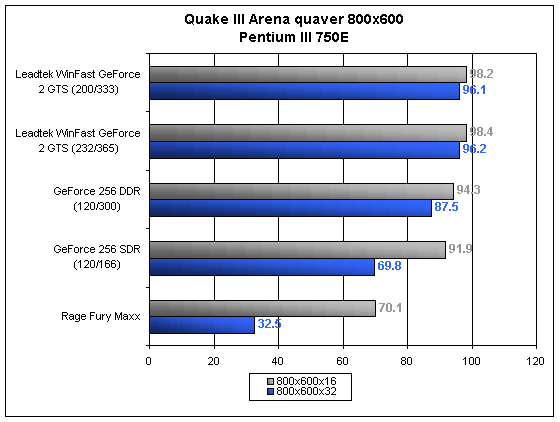


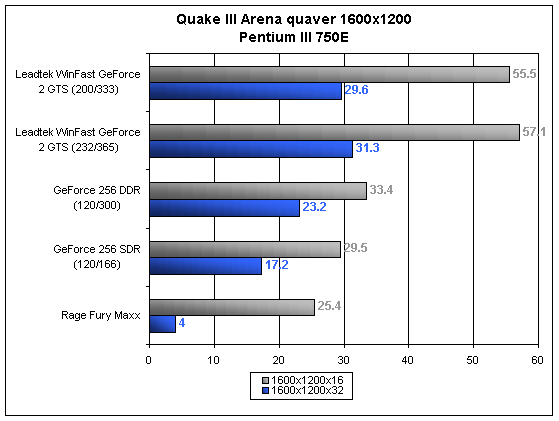
Quaver, a Quake III Arena demo that previously stressed our cards to the max, has become no problem for the GeForce 2 GTS to topple. Due to the use of NVIDIA reference drivers 5.16, S3TC compression was utilized in the demo playback, significantly increasing performance and decreasing texture swapping. The WinFast GeForce 2 GTS performed 66% faster than the GeForce 256 DDR when at both 1280x1024x16 and 1600x1200x16. When overclocked, this difference rose to 71% when at 1600x1200x16. At the playable resolution of 1280x1024 the stock clocked card performed 26% faster than the DDR GeForce 256 and the overclocked card performed 32% faster than the DDR GeForce 256.
Unreal Tournament Performance
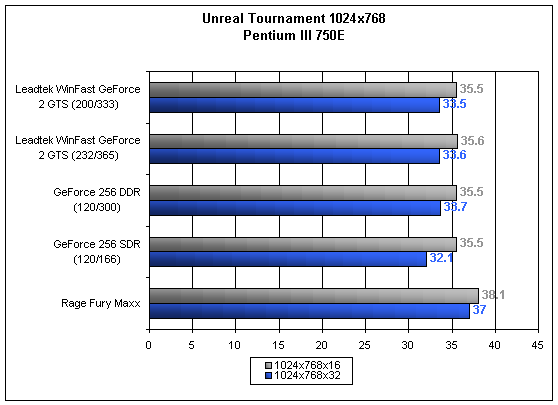
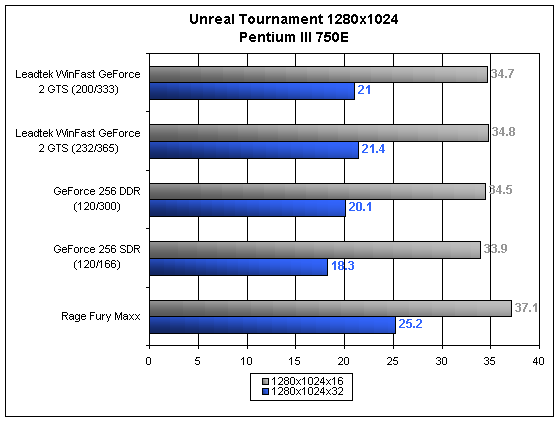
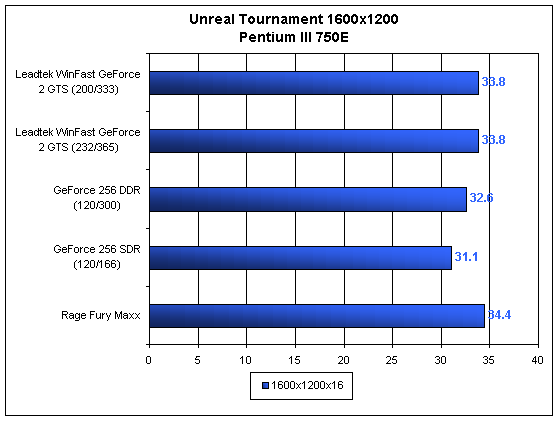
As we have seen many times in the past, Unreal Tournament does not seem to show any video card scaling. Unreal Tournament is more concerned with what CPU you have than what video card you are using. All video cards tested perform almost identically, with the exception of the SDR GeForce 256 in 32-bit color mode, where it is crippled by its low memory bandwidth.
Conclusion
Of the cards to travel the on-line retailer route, the Leadtek WinFast GeForce 2 GTS should be one of the first ones that will be readily available through your favorite on-line retailer. Other cards have a habit of showing up in larger stores first, but Leadtek does not have the brand name recognition or market saturation to do this yet. A simple search on the web should provide plenty of retailers who currently carry or are planning on carrying the Leadtek WinFast GeForce 2 GTS.
How does the card compare to the other GeForce 2 GTS based cards review? As we discussed in our ASUS V7700 review, it seems that every GeForce 2 GTS manufacturer has been adding features to their card to promote sales. We have seen features such as comprehensive warrantees and hardware monitoring. Leadtek attempts to add its feature with the overly large heatsink. Unfortunately, the heatsink does not have the planed effect. The card would have made a much larger impression on the market if it were to have used a normal heatsink and chose to cut prices instead. The Leadtek's WinFast GeForce 2 GTS additional "feature" is really eyecandy meant to lure in the unsuspecting buyer.
This is not to say that the card is bad; not by any stretch of the word. The Leadtek WinFast GeForce 2 GTS proves its ability to play with the big boys by performing as well as competing products in many tests. The $10 video-out option is one of the least expensive video-out daughter cards we have seen, making the video-out powered card for $359 a very strong buy. The quality of the card is also up to par, as is shown by the clear 2D graphics and texts at resolutions as high as 1600x1200.
The software bundle of the Leadtek WinFast GeForce 2 GTS is rather weak compared to some of the competition. With your purchase, you get a software DVD player, a few useless color calibration utilities, and a demo of the modeling tool Cult3D. Software bundle has never been a selling point for AnandTech reader, but more of an added bonus. Unfortunately this bonus proves to be small in the case of the WinFast GeForce 2 GTS. What is the final decision? If you can find the WinFast GeForce 2 GTS at a good price, one significantly lower than the more feature rich competition, it would be a good purchase. Although the card misses out by incorporating such a large heatsink, it remains a quality GeForce 2 GTS based card. It seems pointless, however, to drop $349 on a card that lacks some of the features of the competition.
How It Rates
Please note that the score given is a comparison between the Leadtek WinFast GeForce 2 GTS and other GeForce 2 GTS cards on the market. This is not meant to reflect how GeForce 2 GTS cards compare to other video cards on the market processor wise. To find this information, please see our NVIDIA GeForce 2 GTS review. Also keep in mind that a score of five indicates standard performance. To learn more about our rating system, please click here.
|
AnandTech Video Card Rating |
|
|
Rating
(x/10)
|
|
|
Performance
|
5.0
|
|
Price
|
5.0
|
|
Drivers
|
7.0
|
|
Features
|
4.0
|
|
Retail Availability
|
6.0
|
|
Documentation & Software Bundle
|
4.5
|
| Overall Rating |
5.5
|
Note: The Overall Rating is not an average of all of the categories
How It Rates
Please note that the score given is a comparison between the Leadtek WinFast GeForce 2 GTS and other GeForce 2 GTS cards on the market. This is not meant to reflect how GeForce 2 GTS cards compare to other video cards on the market processor wise. To find this information, please see our NVIDIA GeForce 2 GTS review. Also keep in mind that a score of five indicates standard performance. To learn more about our rating system, please click here.
|
AnandTech Video Card Rating |
|
|
Rating
(x/10)
|
|
|
Performance
|
5.0
|
|
Price
|
5.0
|
|
Drivers
|
7.0
|
|
Features
|
4.0
|
|
Retail Availability
|
6.0
|
|
Documentation & Software Bundle
|
4.5
|
| Overall Rating |
5.5
|
Note: The Overall Rating is not an average of all of the categories

